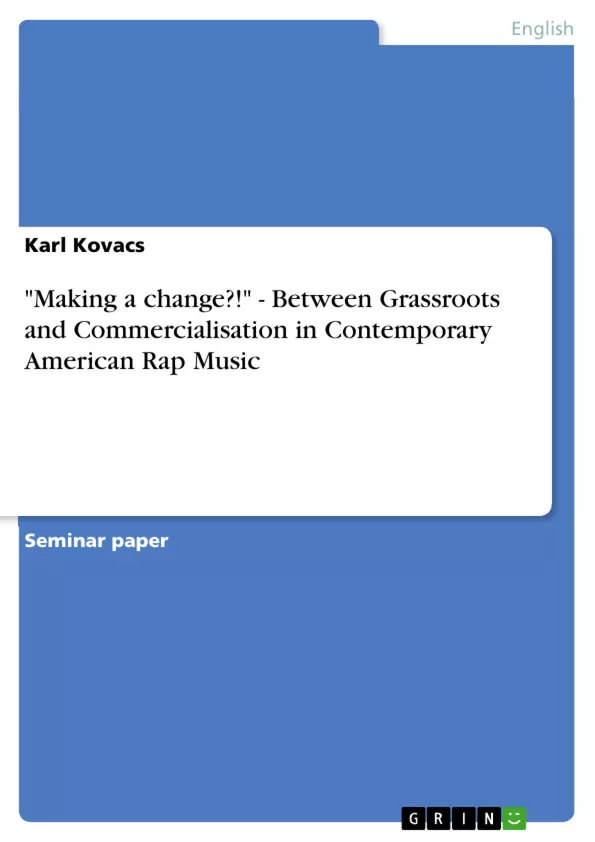The Hip Hop culture between grassroots and commercialzation.
Can rap music bring about social and political change for African Americans or is it merely entertainment?
Table of Contents
- I. Introduction
- II. Hip Hop/Rap
- II. 1. A Definition/ Early Developments
- II. 2. The Development of Modern Rap
Objectives and Key Themes
This work aims to explore the evolution of American rap music from its grassroots origins to its current status as a highly commercialized global industry. It investigates the factors that contributed to hip hop's immense success, examines the diverse styles and themes within the genre, and considers the debate surrounding the balance between artistic expression and commercial exploitation.
- The origins and early development of hip hop culture.
- The diversification of rap music and the emergence of different subgenres.
- The role of language and social commentary in rap music.
- The commercialization of hip hop and its impact on artistic integrity.
- The ongoing tension between artistic expression and commercial success within the hip hop community.
Chapter Summaries
I. Introduction: This introductory chapter establishes the context for the study by highlighting the immense popularity and commercial success of rap music. It raises key questions about the origins of hip hop, its transformation from a grassroots movement to a global industry, and the ongoing debate regarding the impact of commercialization on its core values. The chapter sets the stage for a deeper exploration of these questions, focusing on the American hip hop community as the foundation for global hip hop cultures.
II. Hip Hop/Rap: This chapter is divided into two main sections. II.1. A Definition/Early Developments provides a concise definition of rap music, outlining its essential elements—DJing, rapping, break dancing, and graffiti—and tracing its origins in the Bronx, New York. This section highlights the early pioneers, such as Grandmaster Flash and the Sugarhill Gang, and contrasts their approaches, showcasing the early diversity within the genre—from dance-oriented anthems to socially conscious commentary. The chapter emphasizes the roots of this distinctly African-American art form in West African oral and musical traditions, highlighting its role as a form of cultural resistance and unique expression. II.2. The Development of Modern Rap chronicles the evolution of hip hop in the 1980s. This section introduces artists like LL Cool J and Run-DMC, who brought hip hop into the mainstream through collaborations with rock artists and MTV appearances. It contrasts the commercially oriented style of artists like LL Cool J with more politically and socially conscious rappers, such as Ice-T and Public Enemy, illustrating the ongoing tension between commercial success and social commentary within the genre. The chapter showcases how both commercially driven and socially conscious rap contribute to the overall message of the hip hop movement, while also acknowledging the significant controversies and debates that emerged from the different approaches.
Keywords
Rap music, hip hop culture, commercialization, grassroots movement, social commentary, African-American culture, artistic expression, genre diversification, controversies, mainstream media, DJing, rapping, breakdancing, graffiti, early pioneers, Run-DMC, LL Cool J, Ice-T, Public Enemy.
Frequently Asked Questions: A Comprehensive Language Preview of American Rap Music
What is the overall purpose of this document?
This document provides a comprehensive overview of American rap music, exploring its evolution, key themes, and significant figures. It serves as a preview, including a table of contents, objectives, chapter summaries, and keywords.
What topics are covered in the document?
The document covers the origins and early development of hip hop culture, the diversification of rap music into various subgenres, the role of language and social commentary within the genre, the commercialization of hip hop and its impact on artistic integrity, and the ongoing tension between artistic expression and commercial success.
What are the main themes explored in the document?
Key themes include the evolution of rap from its grassroots origins to its current global status, the interplay between artistic expression and commercial interests, the diverse styles and themes within the genre, and the socio-political commentary often present in rap lyrics.
What is the focus of Chapter I: Introduction?
The introduction establishes the context of the study by highlighting rap music's immense popularity and commercial success. It raises key questions about the origins of hip hop and its transformation into a global industry, focusing on the American hip hop community as a foundation for global hip hop cultures. It sets the stage for a deeper exploration of the impact of commercialization on core values.
What are the key aspects covered in Chapter II: Hip Hop/Rap?
Chapter II is divided into two sections. Section II.1 defines rap music, outlining its essential elements (DJing, rapping, break dancing, graffiti), tracing its origins in the Bronx, and highlighting early pioneers and their diverse approaches. Section II.2 chronicles the evolution of hip hop in the 1980s, introducing artists who brought hip hop into the mainstream and contrasting commercially oriented styles with more socially conscious styles, showcasing the ongoing tension between commercial success and social commentary.
Which artists are mentioned in the document as examples?
The document mentions several key figures, including Grandmaster Flash, the Sugarhill Gang, LL Cool J, Run-DMC, Ice-T, and Public Enemy, illustrating the diversity of styles and approaches within the genre.
What is the intended audience for this document?
The document is intended for academic use, allowing for analysis of themes in a structured and professional manner.
What keywords are associated with this document?
Keywords include: Rap music, hip hop culture, commercialization, grassroots movement, social commentary, African-American culture, artistic expression, genre diversification, controversies, mainstream media, DJing, rapping, breakdancing, graffiti, early pioneers, Run-DMC, LL Cool J, Ice-T, and Public Enemy.
- Citation du texte
- Karl Kovacs (Auteur), 2007, "Making a change?!" - Between Grassroots and Commercialisation in Contemporary American Rap Music , Munich, GRIN Verlag, https://www.grin.com/document/114921



